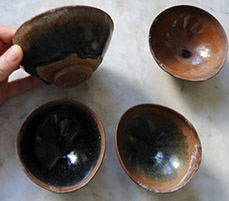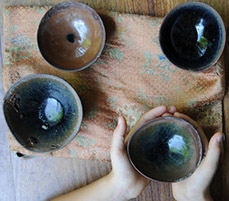The taste of water
Evocation and rawness
Literati taste often favours objects that are raw and unfinished, and yet which seem complete in their vital qualities. This can be seen in two kinds of bowls (both Song, 960-1279). The darker ones are intended for powdered tea, prepared with a light green froth – akin to ‘macha’ still used in the Japanese tea ceremony. The lip of each bowl is rough, the glaze hangs down around the base. The overall form is irregular, though when held in the hand it has a balanced solidity. The dense, brown glaze has a slight transparency that is shot through with iridescence when it takes the light. The pleasure lies in holding, observing and savouring slight variations, made by simple, direct craftsmanship that seems to have more in common with Nature than over-wrought urbanity. While each bowl is unique, yet by family resemblance they could be grouped into a set to share among friends.
A blue-green bowl of the same period has similar qualities, though its hand-scored decoration is more consciously light when compared to the solid gravitas of the darker bowls. It too seems to have been made in a casual, straight-forward way, less as a particular object than as one of many - a product of everyday gestures by craftsmen at ease in their world.
Literati appreciation could compare folk ceramics to calligraphy, similarly projecting onto them an emotional and moral image that one associated with their class of makers. This coincided with views of a society in harmony, where an honest peasantry and simple class of craftsmen were governed by a sympathetic and educated class of hereditary landowners and officeholders.
 |  |  |
| Private collection |
- Page 1
- 2